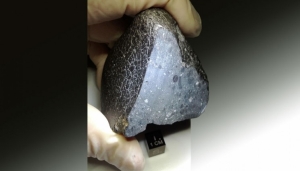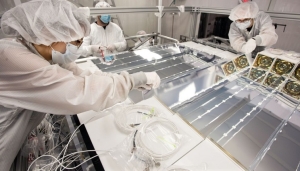LAB REPORT
Science and Technology Making Headlines
May 25, 2018


LLNL scientists are using proteins found in human bones for identification.
Researchers bone up on forensics
Deon Anex and Katelyn Mason are the Sherlock Holmes and Dr. Watson of the Lawrence Livermore National Laboratory.
But instead of fingerprints and a magnifying glass, they're able to ID their suspects by tracking proteins from their bodies.
What they do is very similar to what is done in DNA -- there are markers in DNA that you can make a measurement on and link those to an individual. They are trying to find the analogous strategy with proteins.
They first perfected the technique with hair and more recently expanded it to bones. Protein samples are extracted, then run through a powerful device known as a mass spectrometer. The process can spot patterns in the proteins that are influenced by mutations in a person's DNA. The result is a unique genetic signature, related to DNA, but from a source that's much more durable.


Martian meteorite Northwest Africa (NWA) 7034, nicknamed "Black Beauty," weighs approximately 11 ounces (320 grams). Credit: NASA
Meteorite offers tell-tale clues to Martian crust
By looking at an ancient Martian meteorite that landed in the Sahara Desert, Lawrence Livermore scientists and collaborators have determined how and when the red planet's crustal topographic and geophysical divide formed.
Northwest Africa (NWA) 7034 is the oldest Martian meteorite discovered to date, at approximately 4.4 billion years old. The meteorite is a breccia (it contains a variety of different crustal rocks that were mixed together and then sintered by heating) and is the only sample from Mars with a composition that is representative of the average Martian crust. The meteorite provided the researchers a unique opportunity to study the ancient crust on Mars.
The team applied a number a radioisotopic dating techniques to determine that the divide between the heavily cratered southern highlands of the planet and the smoother plains of the northern lowlands formed prior to the formation of NWA 7034 at 4.4 billion years ago. This ancient age is consistent with a giant impact origin for the crustal divide.


Technicians work on the assembly of the PROSPECT neutrino detector. Photo by PROSPECT collaboration/Mara Lavitt
PROSPECTing for antineutrinos
The Precision Reactor Oscillation and Spectrum Experiment (PROSPECT) has completed the installation of a novel antineutrino detector that will probe the possible existence of a new form of matter.
PROSPECT, located at the High Flux Isotope Reactor at the Department of Energy’s Oak Ridge National Laboratory, has begun taking data to study electron antineutrinos that are emitted from nuclear decays in the reactor to search for so-called sterile neutrinos and to learn about the underlying nuclear reactions that power fission reactors.
Antineutrinos are elusive, elementary particles produced in nuclear beta decay. The antineutrino is an antimatter particle, the counterpart to the neutrino.
“The successful operation of PROSPECT will allow us to gain insight into one of the fundamental puzzles in neutrino physics and develop a better understanding of reactor fuel, while also providing a new tool for nuclear safeguards,” said co-spokesperson Nathaniel Bowden, a scientist at Lawrence Livermore and an expert in nuclear non-proliferation technology.


LLNL researchers have found that heat in the deep ocean has increased dramatically due to climate change.
Ocean is getting hot, hot, hot
The world’s oceans are heating up at an alarming pace, and scientists aren’t sure what to do.
Climate scientists have warned for years that the effects of global warming may be delayed due to the ocean’s tendency to absorb the sun’s radiation, storing heat miles below the surface.They have found that the vast majority of additional absorbed heat in the ocean exists toward the bottom, 35 percent of which can be found deeper than 700 meters below the surface. Over the past 20 years, the solar radiation warming the ocean’s floor has increased by nearly 15 percent.
Lawrence Livermore and NOAA scientists examined the changes in heat content across multiple depths throughout the world’s oceans and compared their findings with models that date as far back as 1865.
The study showed that the heat content in the deepest reaches of the ocean has risen by “several tenths of a degree.” While this is still less than the average 0.5 degrees Celsius that the upper ocean has warmed by, scientists still warn that the increase in deep water has the potential to become a huge problem.





